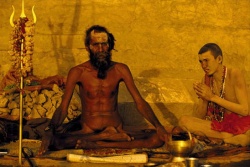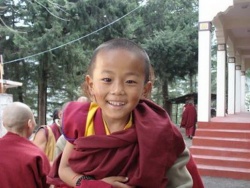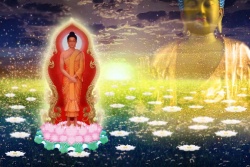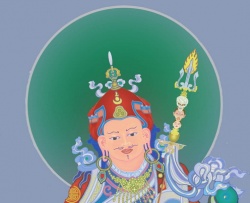Difference between revisions of "Gongma Drakpa Gyaltsen"
| Line 1: | Line 1: | ||
| + | <nomobile>{{DisplayImages|220|2456|4406|1392}}</nomobile> | ||
| Line 6: | Line 7: | ||
| + | [[Gongma Drakpa Gyaltsen]] ([[Gong ma grags pa rgyal mts'an]]) (1374–1432) was a [[King of Tibet]] who ruled in 1385–1432. He belonged to the [[Phagmodrupa dynasty]], which was the leading regime in [[Tibet]] between 1354 and 1435. His reign was comparatively [[tranquil]], but he was also the last [[ruler]] of the {{Wiki|dynasty}} to wield full [[powers]] over the central parts of [[Tibet]]. | ||
| − | [[ | + | ==Accession to the [[throne]]== |
| + | |||
| + | [[Drakpa Gyaltsen]] was the eldest son of [[Shakya Rinchen]], a brother of a former [[ruler]] of the {{Wiki|dynasty}}, [[Jamyang Shakya Gyaltsen]]. His mother was called [[Zina Rinchen Som]]. His father had very briefly succeeded to the rulership of {{Wiki|Central Tibet}} in 1373, but lost his [[mind]] when a house where he stayed overnight caught [[fire]]. The young [[Drakpa Gyaltsen]] was considered an [[incarnation of Jamyang]] ([[Manjushri]], the [[Bodhisattva]] of [[wisdom]]). | ||
| + | |||
| + | Like the other [[Phagmodrupa]] rulers he had a [[monastic]] upbringing, and was [[ordained]] as [[lama]] of the [[Tsethang]] [[monastery]] in 1380. Five years later he was raised to the [[dignity]] of {{Wiki|regent}} of [[Tibet]] by a faction opposed to the current [[ruler]] [[Sonam Drakpa]]. His maternal uncles tried to wield power from behind the [[throne]], but were not able to maintain themselves in the face of the court ministers. | ||
| − | |||
| − | |||
==Successful reign== | ==Successful reign== | ||
| − | After some time [[Drakpa Gyaltsen]] began to {{Wiki|rule}} on his [[own]]. According to the [[Tibetan]] chronicles he had good [[physical]] and [[intellectual]] capabilities. [[Tibet]] made much progress in [[wealth]] and [[prosperity]]. "Power, [[fortune]], and [[wisdom]] were ever [[attached]] to him." Apart from two brief conflicts in the [[Tsang]] region, his reign was [[peaceful]]; "Ü and [[Tsang]] [{{Wiki|Central Tibet}}] became like one soft piece of {{Wiki|silk}}". Unlike the previous rulers, who had been content with the title [[desi]] ({{Wiki|regent}}), [[Drakpa Gyaltsen]] was addressed with the {{Wiki|royal}} titles [[gongma]] (the high one, {{Wiki|superior}}) and [[chogyal]] (saintly [[king]]). He nevertheless remained a [[lama]], and did not marry or beget children. | + | |
| + | After some time [[Drakpa Gyaltsen]] began to {{Wiki|rule}} on his [[own]]. According to the [[Tibetan]] chronicles he had good [[physical]] and [[intellectual]] capabilities. [[Tibet]] made much progress in [[wealth]] and [[prosperity]]. "Power, [[fortune]], and [[wisdom]] were ever [[attached]] to him." Apart from two brief conflicts in the [[Tsang]] region, his reign was [[peaceful]]; "[[Ü]] and [[Tsang]] [{{Wiki|Central Tibet}}] became like one soft piece of {{Wiki|silk}}". Unlike the previous rulers, who had been content with the title [[desi]] ({{Wiki|regent}}), [[Drakpa Gyaltsen]] was addressed with the {{Wiki|royal}} titles [[gongma]] (the high one, {{Wiki|superior}}) and [[chogyal]] (saintly [[king]]). He nevertheless remained a [[lama]], and did not marry or beget children. | ||
==Relations with [[China]]== | ==Relations with [[China]]== | ||
| − | The {{Wiki|Hongwu Emperor}} of [[China]] heard of his accession in 1388 and conferred the title [[Guanding]] [[Guoshi]] upon him. Later, in 1406, the {{Wiki|Ming Emperor}} sent a [[jade]] {{Wiki|seal}} with a dragon-headed button to [[Drakpa Gyaltsen]], together with 500 ounces of {{Wiki|silver}}, three dresses of {{Wiki|silk}}, flowered stuffs, fifty bolts of {{Wiki|silk}}, and 200 pounds of Bashan tea. Envoys continued to be dispatched back and forth during [[Drakpa | + | The {{Wiki|Hongwu Emperor}} of [[China]] heard of his accession in 1388 and conferred the title [[Guanding]] [[Guoshi]] upon him. Later, in 1406, the {{Wiki|Ming Emperor}} sent a [[jade]] {{Wiki|seal}} with a dragon-headed button to [[Drakpa Gyaltsen]], together with 500 ounces of {{Wiki|silver}}, three dresses of {{Wiki|silk}}, flowered stuffs, fifty bolts of {{Wiki|silk}}, and 200 pounds of Bashan tea. Envoys continued to be dispatched back and forth during [[Drakpa Gyaltsen's]] long reign. The [[king]] received the title wang ({{Wiki|prince}}) from the [[Mings]], as did the [[religious]] [[lords]] of [[Drigung Monastery|Drigung]], [[Tsedong]] and [[Ling]]. They were known as "the[[ four wang of Tibet]]". |
==[[Religious]] {{Wiki|patronage}}== | ==[[Religious]] {{Wiki|patronage}}== | ||
| − | [[Gongma Drakpa Gyaltsen]] was a {{Wiki|patron}} of [[Tsongkhapa]], the well-known renovator of [[Tibetan Buddhism]]. With his endorsement, [[Tsongkhapa]] and his closest [[disciples]] were able to found the [[monasteries]] of [[Ganden Monastery|Ganden]] (1409), [[Drepung Monastery|Drepung]] (1416), and [[Sera Monastery|Sera]] (1419). In 1414 the [[gongma]] invited [[Tsongkhapa]] to teach the [[tenets]] of his school (later known as [[Gelugpa]]) in Drashi Dokha. A [[monk]] from [[Tsang]] called [[Gedun Drub]] attended the [[sermons]] and subsequently became a [[disciple]] of [[Tsongkhapa]]; he would later be counted as the | + | [[Gongma Drakpa Gyaltsen]] was a {{Wiki|patron}} of [[Tsongkhapa]], the well-known renovator of [[Tibetan Buddhism]]. With his endorsement, [[Tsongkhapa]] and his closest [[disciples]] were able to found the [[monasteries]] of [[Ganden Monastery|Ganden]] (1409), [[Drepung Monastery|Drepung]] (1416), and [[Sera Monastery|Sera]] (1419). In 1414 the [[gongma]] invited [[Tsongkhapa]] to teach the [[tenets]] of his school (later known as [[Gelugpa]]) in [[Drashi Dokha]]. |
| + | |||
| + | A [[monk]] from [[Tsang]] called [[Gedun Drub]] attended the [[sermons]] and subsequently became a [[disciple]] of [[Tsongkhapa]]; he would later be counted as the [[First Dalai Lama]]. In 1409 the [[gongma]] and his [[minister]] [[Neu Namkha Zangpo]] enabled [[Tsongkhapa]] to arrange the first [[Monlam festival]] in [[Lhasa]]. | ||
| + | |||
| + | This three-weeks long [[prayer]] {{Wiki|festival}} was subsequently held once a year and attracted many thousands of [[pilgrims]] and [[monks]]. However, the [[king]] was not solely supportive of the [[Gelugpa school]], but listened to a wide array of divines, including the [[Gelugpa]]'s later rival [[Karmapa]]. | ||
==Demise== | ==Demise== | ||
Latest revision as of 14:51, 15 December 2015
Gongma Drakpa Gyaltsen (Gong ma grags pa rgyal mts'an) (1374–1432) was a King of Tibet who ruled in 1385–1432. He belonged to the Phagmodrupa dynasty, which was the leading regime in Tibet between 1354 and 1435. His reign was comparatively tranquil, but he was also the last ruler of the dynasty to wield full powers over the central parts of Tibet.
Accession to the throne
Drakpa Gyaltsen was the eldest son of Shakya Rinchen, a brother of a former ruler of the dynasty, Jamyang Shakya Gyaltsen. His mother was called Zina Rinchen Som. His father had very briefly succeeded to the rulership of Central Tibet in 1373, but lost his mind when a house where he stayed overnight caught fire. The young Drakpa Gyaltsen was considered an incarnation of Jamyang (Manjushri, the Bodhisattva of wisdom).
Like the other Phagmodrupa rulers he had a monastic upbringing, and was ordained as lama of the Tsethang monastery in 1380. Five years later he was raised to the dignity of regent of Tibet by a faction opposed to the current ruler Sonam Drakpa. His maternal uncles tried to wield power from behind the throne, but were not able to maintain themselves in the face of the court ministers.
Successful reign
After some time Drakpa Gyaltsen began to rule on his own. According to the Tibetan chronicles he had good physical and intellectual capabilities. Tibet made much progress in wealth and prosperity. "Power, fortune, and wisdom were ever attached to him." Apart from two brief conflicts in the Tsang region, his reign was peaceful; "Ü and Tsang [[[Wikipedia:Central Tibet|Central Tibet]]] became like one soft piece of silk". Unlike the previous rulers, who had been content with the title desi (regent), Drakpa Gyaltsen was addressed with the royal titles gongma (the high one, superior) and chogyal (saintly king). He nevertheless remained a lama, and did not marry or beget children.
Relations with China
The Hongwu Emperor of China heard of his accession in 1388 and conferred the title Guanding Guoshi upon him. Later, in 1406, the Ming Emperor sent a jade seal with a dragon-headed button to Drakpa Gyaltsen, together with 500 ounces of silver, three dresses of silk, flowered stuffs, fifty bolts of silk, and 200 pounds of Bashan tea. Envoys continued to be dispatched back and forth during Drakpa Gyaltsen's long reign. The king received the title wang (prince) from the Mings, as did the religious lords of Drigung, Tsedong and Ling. They were known as "thefour wang of Tibet".
Religious patronage
Gongma Drakpa Gyaltsen was a patron of Tsongkhapa, the well-known renovator of Tibetan Buddhism. With his endorsement, Tsongkhapa and his closest disciples were able to found the monasteries of Ganden (1409), Drepung (1416), and Sera (1419). In 1414 the gongma invited Tsongkhapa to teach the tenets of his school (later known as Gelugpa) in Drashi Dokha.
A monk from Tsang called Gedun Drub attended the sermons and subsequently became a disciple of Tsongkhapa; he would later be counted as the First Dalai Lama. In 1409 the gongma and his minister Neu Namkha Zangpo enabled Tsongkhapa to arrange the first Monlam festival in Lhasa.
This three-weeks long prayer festival was subsequently held once a year and attracted many thousands of pilgrims and monks. However, the king was not solely supportive of the Gelugpa school, but listened to a wide array of divines, including the Gelugpa's later rival Karmapa.
Demise
Gongma Drakpa Gyaltsen died in 1432 after 47 years on the throne. His death was only noted by the Ming court in 1440. At his demise he was succeeded by his nephew Drakpa Jungne, whose mother belonged to the powerful feudatory family Rinpungpa in Tsang. However, dynastic turmoil and localism among the regional lords led to a breakdown of Phagmodrupa power three years after the accession of the new king.
Source
Wikipedia:Gongma Drakpa Gyaltsen



